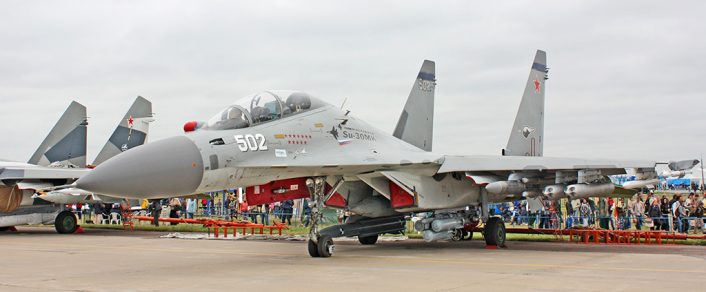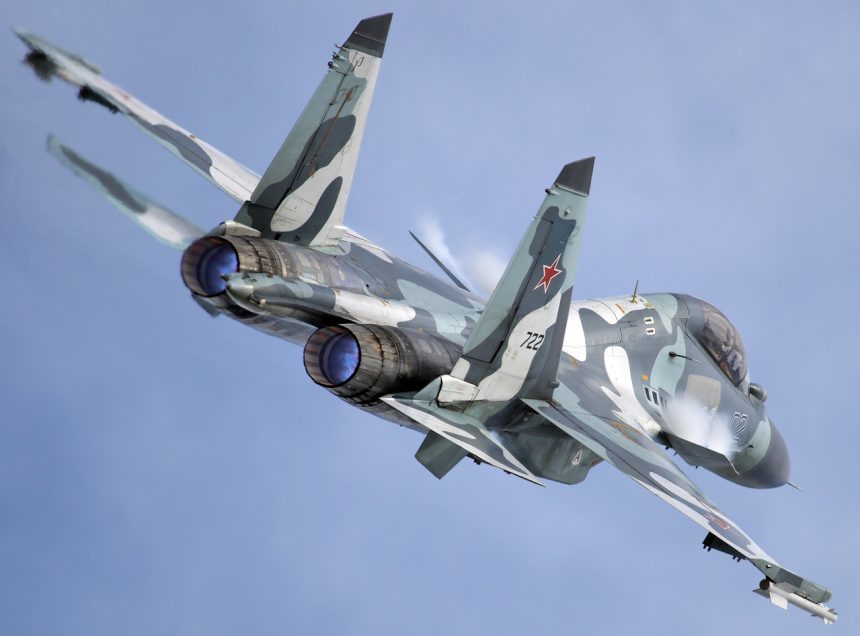Multirole Sukhoi to Become Primary Combat Aircraft of Myanmar Air Force.
Myanmar has confirmed its commitment to purchase six new Russian-built Sukhoi Su-30 multi-role advanced tactical aircraft. Russian news agency TASS quoted the Russian Deputy Defense Minister, Lt. Gen Alexander Fomin, as saying the new Su-30s will, “become the main fighter aircraft of Myanmar’s air force”.
Myanmar, bordered by China, India, Laos, Thailand and Bangladesh, currently operates a significant number of MiG-29 aircraft, quoted as being around 39 aircraft with little reliable information about how many are combat-ready. According to reports from several Asian and western media outlets including FlightGlobal.com, Myanmar also may have orders for 16 Chengdu/Pakistan Aeronautical Complex JF-17 fighters.
Although no detail about the Sukhoi Su-30 variant that Myanmar will operate has been made public, some sources believe it will probably be a version closely related to the Su-30SME unveiled at the Singapore Airshow in 2016. When the Su-30SME export version for Singapore was announced at the Singapore Airshow, Irkut Corporation President Oleg Demchenko was quoted by Jane’s Defense as saying, “The Su-30SME is an upgraded modern platform based on Russian equipment. As the basic Russian Su-30SM version develops, the capabilities of the export Su-30SME will also expand.” This claimed modular expandability is a feature of the U.S. F-35 Joint Strike Fighter program and is attractive to potential buyers since it provides an open-source, modular approach to keeping tactical aircraft current in technology and capabilities.
According to data published by Jane’s Defense, the Sukhoi Su-30SME export version, likely similar to the version that will go to Myanmar, will have a normal take-off weight of 26,090 kg. and a max take-off of 34,000 kg. Interestingly, the quoted thrust in Jane’s Defense was 25,000 kg, putting the thrust-to-weight ratio of the Su-30SME below 1:1. Operational range is quoted as 1,280 km and top speed is said to be Mach 1.75.
Jane’s Defense tells us the Su-30SME uses two AL-31FP afterburning jet engines with thrust vectoring nozzles for enhanced directional control. The combination of two of these powerplants on the SU-30SME give the aircraft a combat payload of up to 8,000 kg spread among 12 external hardpoints on the fuselage and wings.
If there is one area the Su-30SME and related versions may be down-speced relative to western counterparts it may be avionics connectivity, or the ability to share data gathered by the aircraft’s sensors with other aircraft and weapons systems. As described, the avionics suite of the Su-30SME sounds like an essentially “closed loop” system without mention of datalink capability, a potential force-multiplier. The Su-30SME can carry externally mounted infrared and laser targeting pods for ground target acquisition and terminal precision weapon guidance. The fire control radar can acquire and track 15 targets simultaneously in air-to-air mode while being able to manage four attacks simultaneously. Passive, non-emitting sensors on the Su-30SME include an electro-optical targeting sensor combined with a laser inertial navigation system. There is also a helmet-mounted target designator, and satellite GPS navigation system compatible with the GLONASS and NAVSTAR formats. It is likely, however, that if a datalink system in not already available among the avionics suite for the Su-30SME and related versions, that capability will likely be developed soon.

Anyway, whatever the version Myanmar will get, the sale of these six Su-30s is significant not only because of the country’s history and role in the region, which is somewhat volatile; more significantly it continues a significant run of sales successes for the Russian aircraft industry.
But while the Russians have seen unit sale growth in their military aircraft exports, their “ticket average” or cost per aircraft unit sale still trails the U.S. Those lower ticket averages per aircraft may be a part of their success. Russia has been able to offer highly capable tactical aircraft to countries that cannot participate in most western defense consortiums for both economic and political reasons. As the air forces of some African and Asian countries have become obsolete and degraded by age the new Russian military empire formed after the collapse of the Soviet Union has moved in to fill the supply vacuum of military aircraft.
However, the dollar volumes (if not unit numbers) worldwide still favor the United States aircraft suppliers. Five of the top six arms producing companies in gross sales as reported in 2006 were US-headquartered companies. All were primarily aerospace. Those companies were Boeing, Lockheed Martin, Northrop Grumman, Raytheon and General Dynamics. That trend has continued after 2010 with the introduction of massive programs like the Lockheed Martin F-35 Lightning II Joint Strike Fighter, often quoted as the most expensive defense project in history.
There was no mention of the date of delivery for the six aircraft to Myanmar or if there would be a potential for follow-on acquisition of more aircraft. An interesting mention in the Myanmar Times on Jan. 23, 2018 said that the aircraft will be, among the others, “suitable for Myanmar’s counter-insurgency operations.” That may hint at some of the aircraft’s tasking in the region, even though the Yak-130 advanced jet trainer/light attack aircraft that Myanmar Air Force already flies (six out of 12 examples have already been delivered) is probably more suitable to undertake that kind of mission.
Top image credit: TASS









